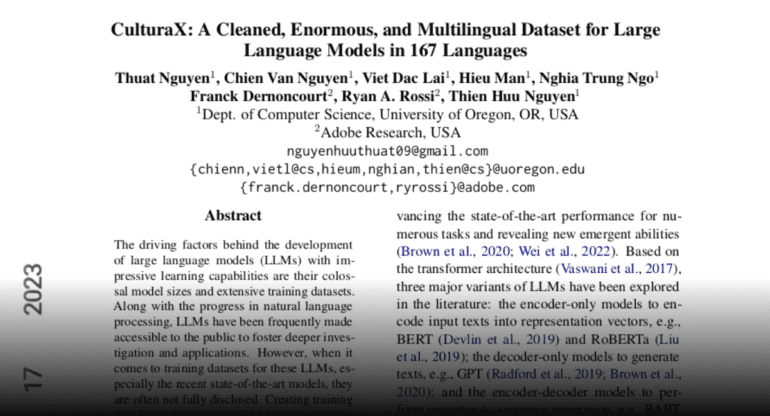TL;DR:
- Large Language Models (LLMs) have revolutionized NLP, but their power depends on massive model sizes and training datasets.
- CulturaX, a 6.3 trillion-token multilingual dataset in 167 languages, emerges as a solution to the scarcity of comprehensive LLM training data.
- Created by a collaboration between the University of Oregon and Adobe Research, CulturaX is meticulously cleaned and deduplicated.
- It offers superior quality and scale compared to existing datasets, addressing limitations like fuzzy deduplication and language recognition.
- HuggingFace’s release of CulturaX paves the way for innovative multilingual LLM research and applications.
Main AI News:
In the dynamic realm of Natural Language Processing (NLP), the ascent of Large Language Models (LLMs) has been nothing short of revolutionary. These models, with their unparalleled prowess, have redefined the landscape of NLP research and applications, catalyzing breakthroughs in myriad tasks and unearthing emergent capabilities.
The journey towards LLM excellence has seen a trifecta of model architectures: encoder-only models for text representation, decoder-only models for text generation, and encoder-decoder models for sequence-to-sequence tasks. However, the true magic behind their remarkable performance lies in adhering to the scaling laws, entailing exponential growth in model sizes and training datasets. The transition from modest models like BERT, housing a mere few hundred million parameters, to the contemporary GPT-based behemoths boasting hundreds of billions of parameters, exemplifies this evolution.
What is the driving force behind these colossal strides in LLMs? Massive model sizes and expansive training datasets. As the field of Natural Language Processing has matured, access to LLMs has become more democratized, fostering deeper exploration and practical applications. Nevertheless, a lingering challenge persists – the paucity of comprehensive training datasets for state-of-the-art LLMs. Crafting pristine training data demands arduous data cleaning and deduplication efforts, leading to opacity in training data sources and hindering efforts to validate findings and advance research in mitigating hallucination and bias in LLMs.
Multilingual learning, in particular, grapples with the scarcity of well-curated multilingual text data. This challenge underscores the absence of an open-source dataset capable of training LLMs across a diverse linguistic spectrum. CulturaX, a monumental multilingual dataset encompassing a staggering 6.3 trillion tokens across 167 languages, emerges as the antidote to this conundrum. Conceived through a collaborative effort between academic luminaries at the University of Oregon and Adobe Research, CulturaX embodies an unwavering commitment to the highest data quality standards. It undergoes a meticulous pipeline encompassing language identification, URL-based dataset filtration, metric-driven data cleaning, document refinement, and exhaustive deduplication processes.
CulturaX, with its exhaustive document-level cleaning and deduplication regimen, stands as a beacon of quality in the realm of multilingual LLM training. This ardent data cleansing process leaves no stone unturned, eliminating inaccuracies, false language identification, spurious data, and extraneous non-linguistic material.
Key Features
- CulturaX reigns as the largest open-source, multilingual dataset, meticulously groomed for LLM and NLP applications.
- Offering a treasure trove of multilingual, open-source data, CulturaX addresses the shortcomings of existing datasets, providing high-quality, immediately applicable data for LLM training.
- While other multilingual datasets exist, such as mC4, they pale in comparison to CulturaX’s quality and scale, particularly for generative models like GPT. The absence of document-level deduplication and subpar language recognition in mC4 and OSCAR underscore their limitations. Meanwhile, CC100 offers data only up to 2018, and BigScience ROOTS offers a mere glimpse of data in 46 languages.
Conclusion:
CulturaX’s introduction signifies a significant shift in the NLP market. Its comprehensive, high-quality multilingual dataset equips businesses and researchers with the tools to develop more effective language models, enabling them to navigate diverse linguistic challenges with unprecedented precision. This resource opens up new avenues for innovation and market competitiveness, setting the stage for a transformative era in language processing technologies.

